Ernest Mauviel must be rolling over in his grave.
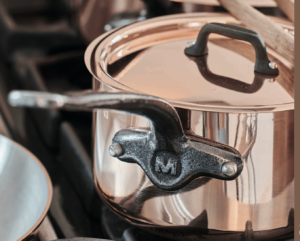 My thanks to reader Martin for noticing these events, which prompted me to take a closer look.
My thanks to reader Martin for noticing these events, which prompted me to take a closer look.
For copper traditionalists, Mauviel’s 2021 catalog bears good news and bad news.
The good news is that cast iron handles are back. For 2021, Mauviel reveals a new addition to the copper-steel bimetal M’Héritage line: the M’200CI with a true cast iron handle, a welcome return to form. In 2015, the company stopped producing pans with cast iron handles and instead used cast stainless steel handles with an “electroplated iron finish” — a matte black coating that was marketed as a sort of ersatz cast iron. Though Mauviel at the time portrayed the change as a response to consumer demand, the coated steel handles seemed a dubious improvement. I am not surprised that the company is restoring the real thing.
The bad news is that the M’200 replaces the M’250 line, the flagship of Mauviel’s M’Héritage series, and this is a downgrade in quality. As the number suggests, M’200 is 2mm thick instead of the M’250’s 2.5mm. Mauviel takes pains to point out that this bimetal is still 90% copper and 10% stainless steel, but whereas the M’250 was 2.3mm of copper, the M’200 is now 1.8mm of copper. In other words, the M’200 has 20% less copper content than the M’250 it replaces.
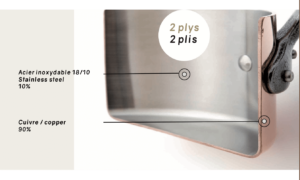
(I take no pleasure in pointing out that the cutaway photo for the new M’200 line on page 122 of the 2021 catalog actually shows the M’250. You can see the photo at right, and it first appeared in the 2015 catalog. This means that the diagram shows the generous 2.3mm copper thickness of the M’250 line, whereas an actual M’200 pan will have 1.8mm.)
I am disappointed at the elimination of the M’250 line and puzzled at the business decision.
Up until 2007, all of Mauviel’s 1.6mm to 2mm thick copper, whether tin- or steel-lined, was sold as sur table grade — that is, insufficiently thick for stovetop use and therefore best reserved for serving prepared food at the table. Proper cooking grade was 2.5mm thick or more, called extra fort. After 2007, Mauviel softened its marketing language a bit and the 1.5mm M’150 line became “standard use” while the 2.5mm M’250 line remained “professional use.”
But now, in 2021, that distinction appears to have become inconvenient. According to Mauviel, the 2mm M’200 line is now “professional use” and 2.5mm bimetal is a thing of the past. This defies the company’s own long-standing representation of its products and is certainly not based on the inherent qualities of the cookware; but perhaps the overriding purpose is to help the marketing department justify two uncomfortably similar product lines that present no real functional differentiation.
And that leads me to a second issue: the relationship of price to value. The M’200 line has 20% less copper than the M’250 line, and so shouldn’t it be priced accordingly? If the prices I am seeing right now at Mauviel’s USA-based online store represent their pricing tiers going forward, I am struggling to make sense of their strategy. The website appears to be in some disarray: currently there is the existing M’150C (“electroplated iron finish” handle), M’150CI (new cast iron handle), the new M’200CI (new cast iron handle), M’250C (becoming obsolete), and, oddly, “M’250CI” which shouldn’t exist. Perhaps Mauviel tried a limited run of M’250 with the new handle and is hoping to sell them? In any event, the prices for these mysterious “M’250CI” pieces are the same as those listed for their brass-handled “B” counterparts, so I will assume they are representative.
I’ve captured list prices from Mauviel’s website on July 11, 2021 across a few comparable pieces (that is, with the “C” and “CI” handles), supplemented with earlier data from January 2021 for some items that are now out of stock, to see how they are pricing these tiers.
| Item | M’150C (previous handle) |
M’150CI (new handle) |
M’200CI (new) |
M’250C (obsolete) | M’250CI (shouldn’t exist) |
|---|---|---|---|---|---|
| Frying pan, 20cm/7.9 in | $210 | $220 | $290 | $265 | |
| Frying pan, 26cm/10.2 in | $265 | $265 | $375 | $315 | |
| Frying pan, 30cm/11.9 in | $310 | $355 | $435 | $420 | |
| Rondeau with lid, 24cm/9.4 in | $485 | $620 | $620 | ||
| Sauté with lid, 24cm/9.4 in | $420 | $460 | $525 | $525 | |
| Saucepan with lid, 12cm/4.7 in | $180 | $210 | |||
| Saucepan with lid, 14cm/5.5 in | $220 | $265 | |||
| Saucepan with lid, 16cm/6.3 in | $265 | $265 | $315 | $315 | |
| Saucepan with lid, 18cm/7.1 in | $330 | $365 | $390 | $390 | |
| Saucepan with lid, 20cm/7.9 | $365 | $420 | $420 | ||
| Stewpan with lid, 24cm/9.4 in | N/A | $520 | $715 | $712 |
Here’s what I’m seeing.
- A 2mm frying pan will cost more than what a 2.5mm frying pan cost previously.
- A 2mm saucepan will cost the same as what a 2.5mm saucepan cost previously.
- Before, when deciding between 1.5mm and 2.5mm saucepans, you would spend about $30-$60 more to get 75% more copper; now for the same price premium you will get only 40% more copper.
- For some 1.5mm pieces, you will pay a $30-$40 price premium for a cast iron handle on the same pan; other pieces are priced the same with either handle.
I am not a consumer pricing expert, but based on what I see, Mauviel’s pricing is not tied to the actual differentiator between their product lines, and that is their copper content. Wouldn’t a consumer expect to see the M’200 priced somewhere between the M’150 and M’250? Instead, as you can see above, the M’200 is priced at or above the comparable M’250 piece as though they were equivalent.
This change leaves Mauviel in an interesting place: going forward, their only true professional grade copper products will be the tin-lined M’Tradition at 2.6mm. Fortunately for us, in addition to braisières, turbotières, poissonières, pommes-Anna and other legacy pieces, Mauviel offers an assortment of sturdy stovetop pots and pans that can serve as the core of a batterie de cuisine en cuivre.
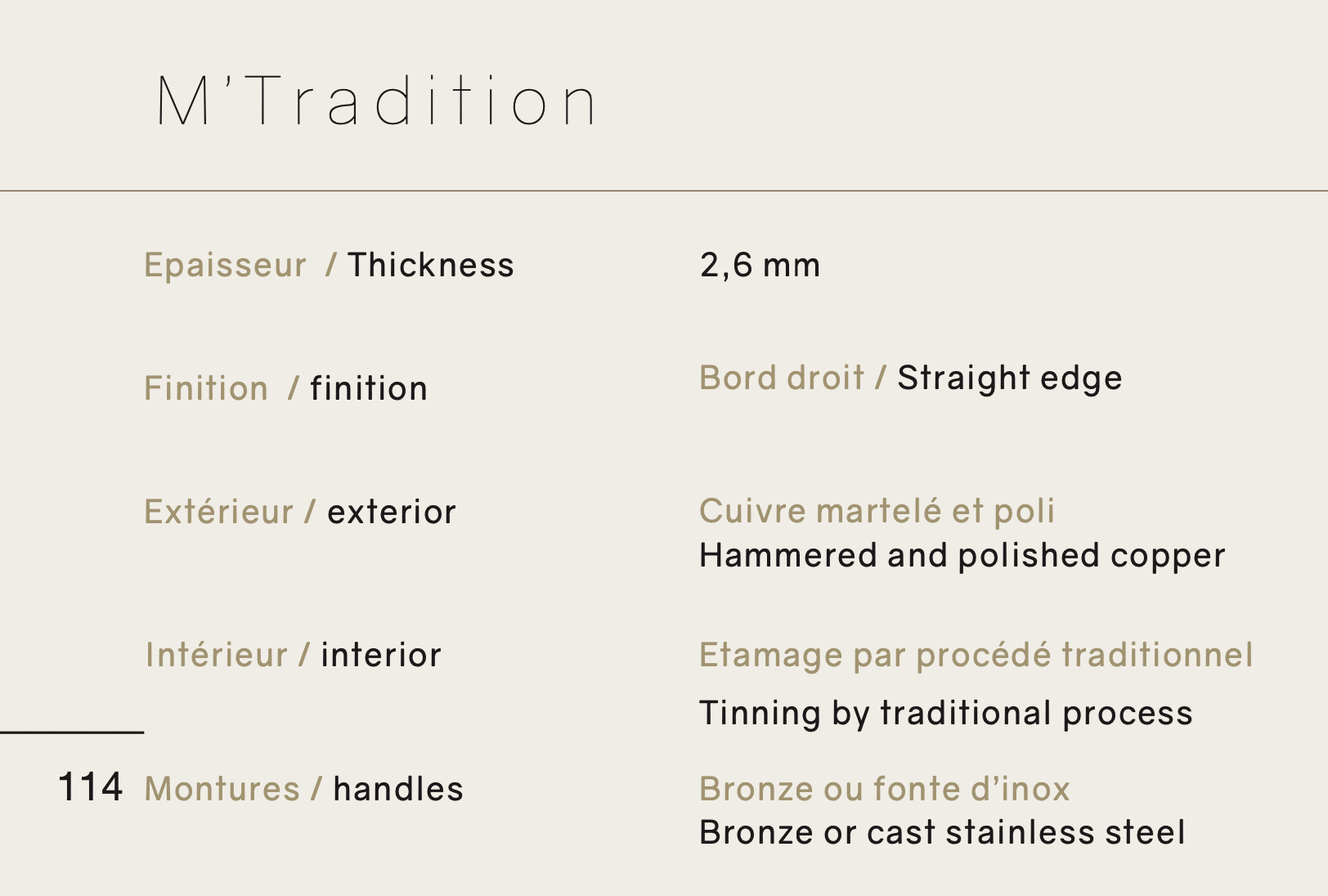
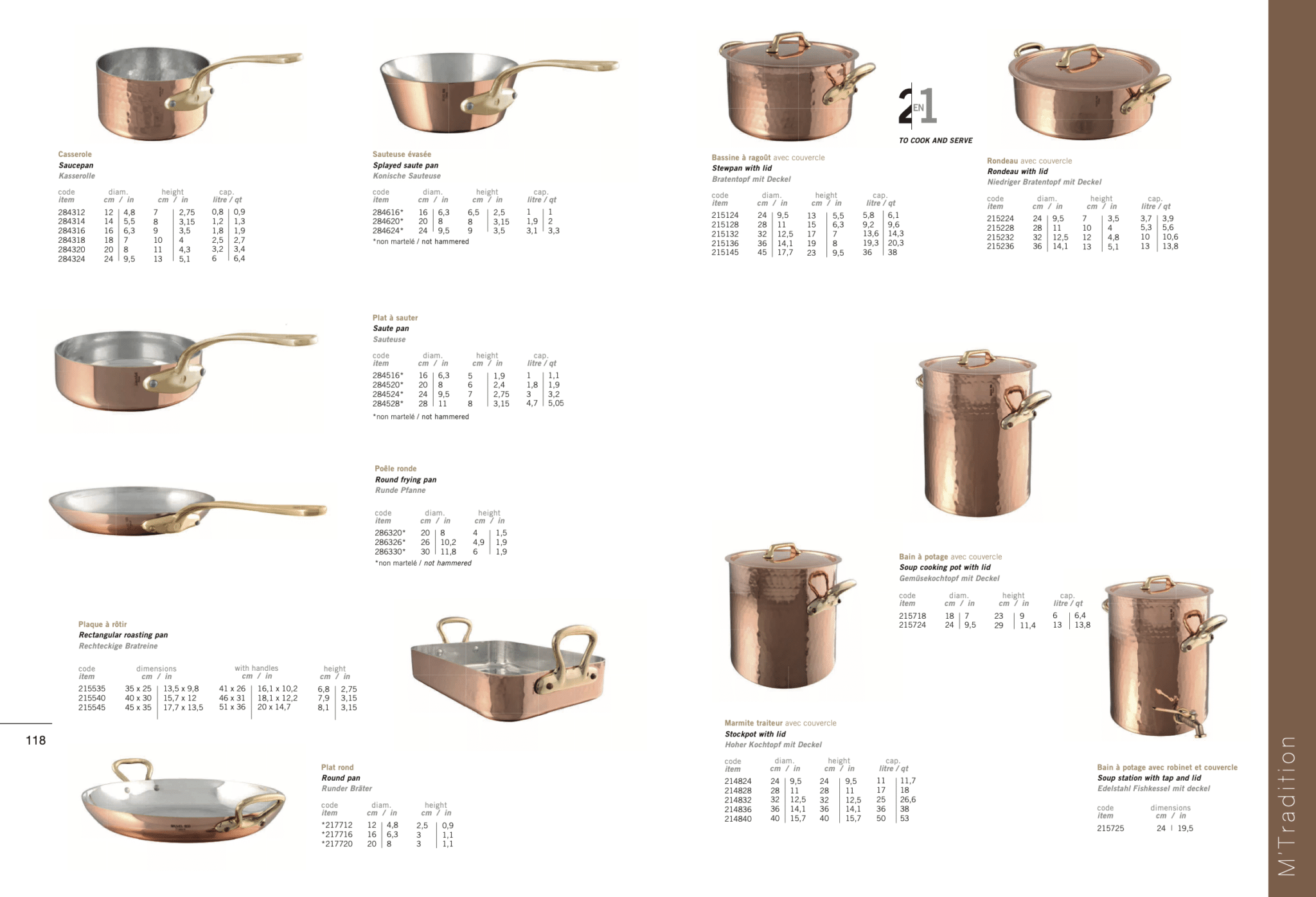
But note that the handle offerings are limited to bronze (that is, brass) and stainless steel. The coveted “CI” cast iron handles are reserved for the copper-steel bimetal M’150 and M’200 lines and the M’Cook 5-ply line. (The “electroplated iron finish” handles are no more.) This means that the only stay-cool handle option for new-production tinned copper is shiny polished cast steel; if you prefer the look of copper against iron, your only option is 1.5mm or 2mm bimetal.
My feelings about these developments at Mauviel is mixed. On one hand, I am glad to see that Mauviel is maintaining the M’Tradition line. I have feared for the last few years that Mauviel would abandon straight-gauge copper altogether; the company’s product lines have ballooned to a range of bimetal, multi-ply, carbon steel, and aluminum offerings, and that is a lot of production to sell. I foresaw a future for the company wherein tinned copper was sidelined as limited-run curiosity pieces and I am glad to see M’Tradition still commanding a multi-page spread in the 2021 catalog.
But on the other hand, I am sad to see Mauviel attempting to train consumers to lower their expectations. 2.5mm bimetal and 2.0 bimetal are not the same thing. I am sure there are solid business reasons for Mauviel to drop the M’250 — goodness knows the pandemic has affected global industry in ways I can hardly imagine. But there is a reason why Mauviel and every other French maker consistently characterized 2mm copper as table service grade, and in my opinion it is flat-out disingenuous for Mauviel to pretend otherwise.
My advice? Don’t buy M’200 thinking it’s the same as M’250. In fact, dollar for dollar, the M’200 isn’t worth the price. Falk and Matfer-Bourgeat (but not de Buyer, as I erroneously thought) are now your best resources for new 2.5mm bimetal copper. Mauviel’s 2.6mm M’Tradition tinned copper is fine, but I don’t recommend brass handles and the only other option is the polished stainless steel. But for similar prices you can buy thicker brand-new pieces with cast iron handles from Brooklyn Copper Cookware, Duparquet, and House Copper. And of course, you can always buy vintage.
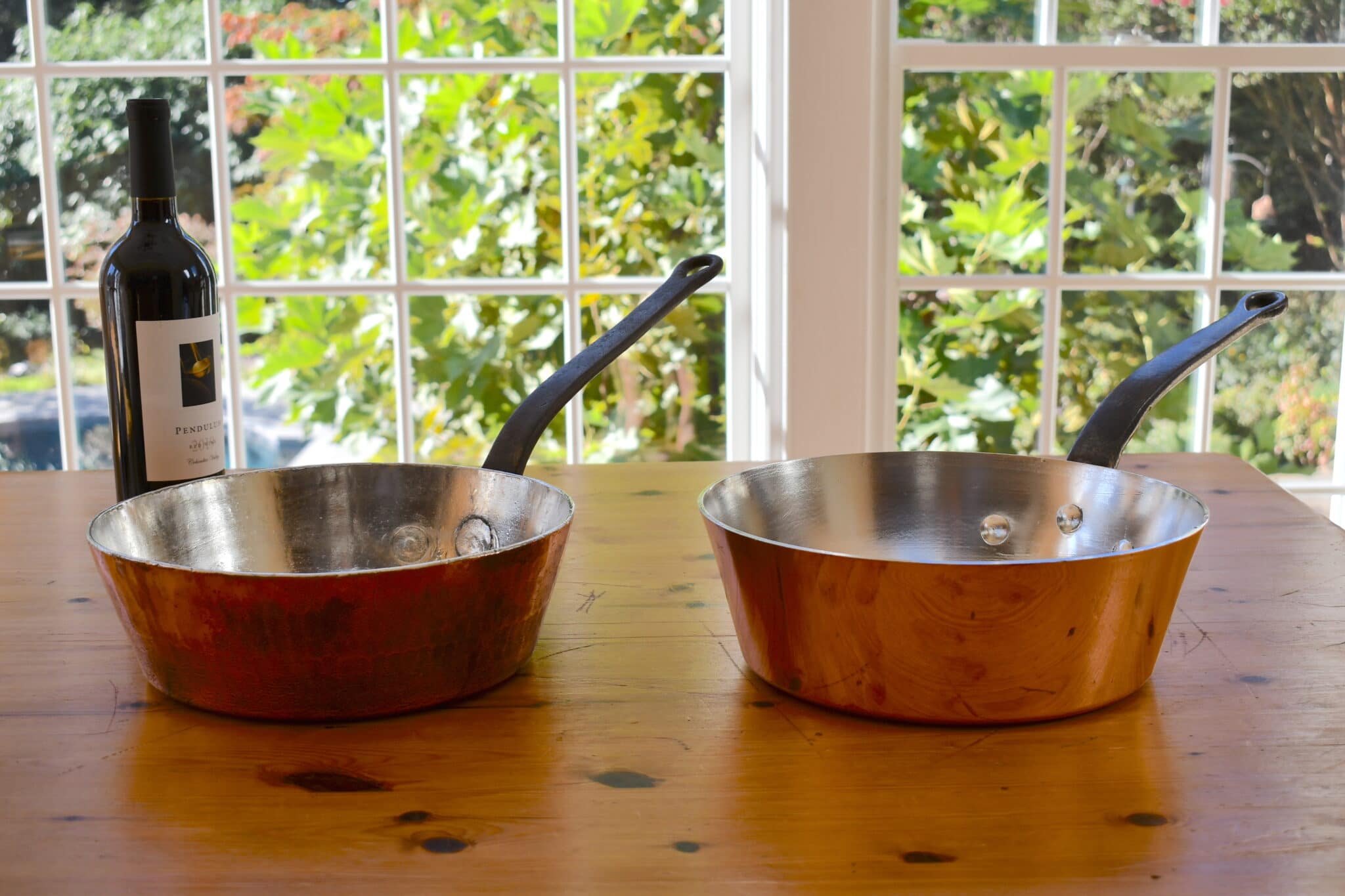
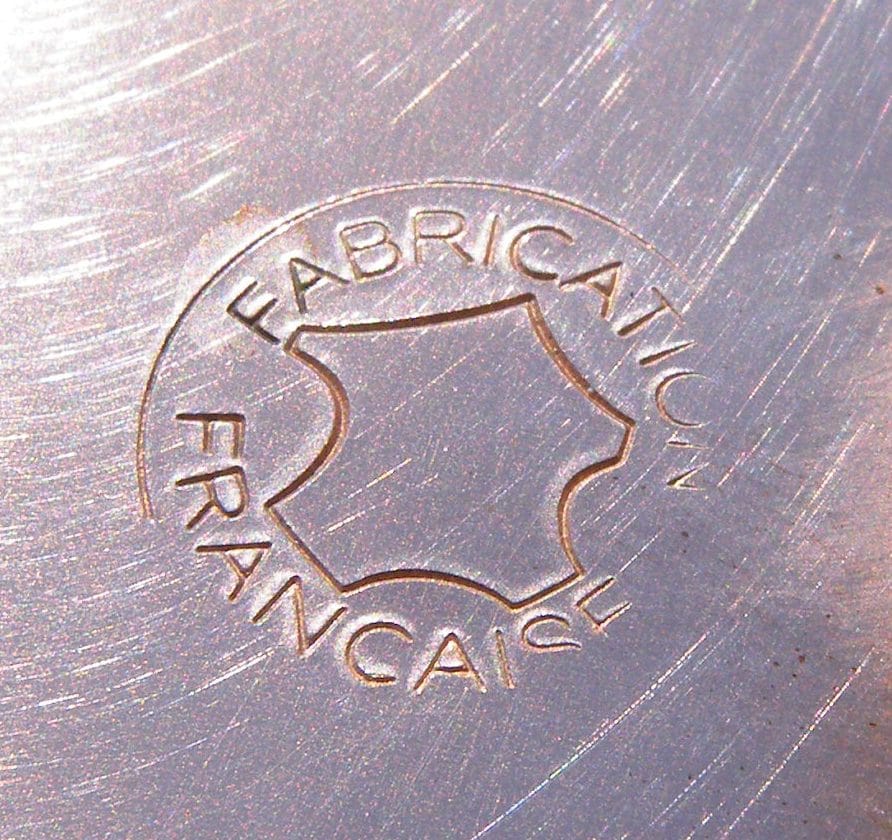
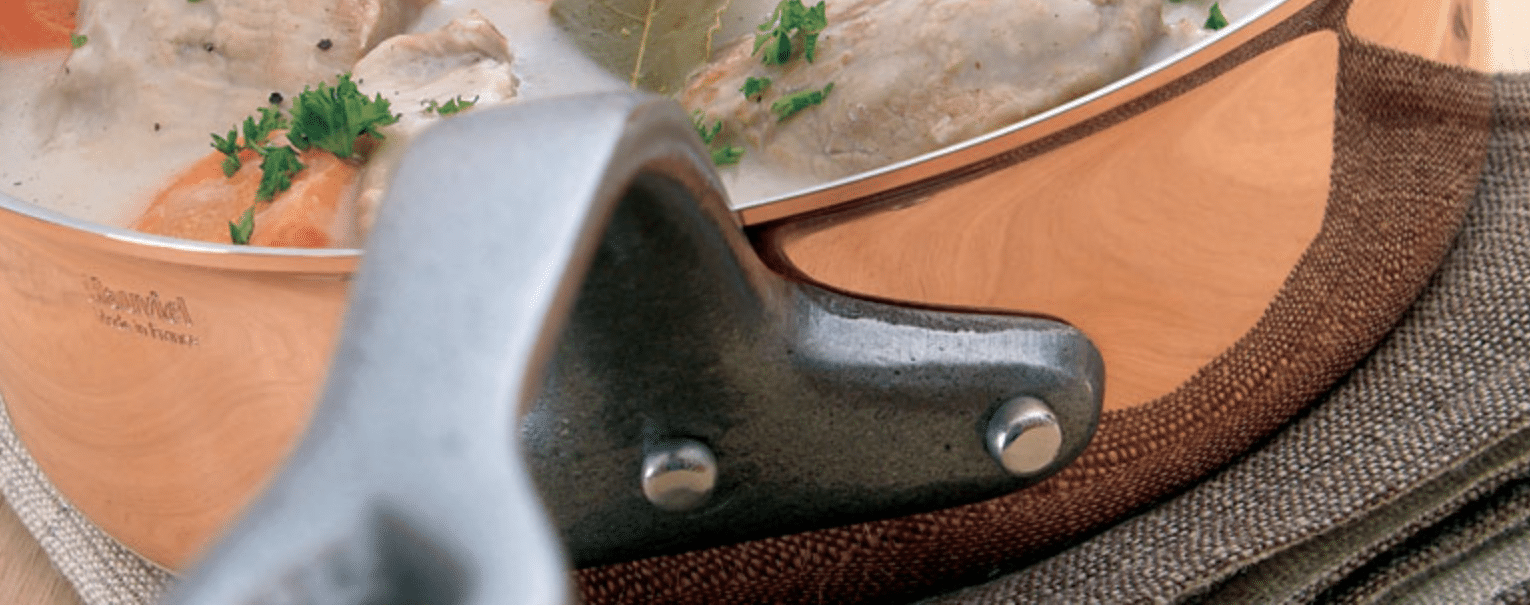
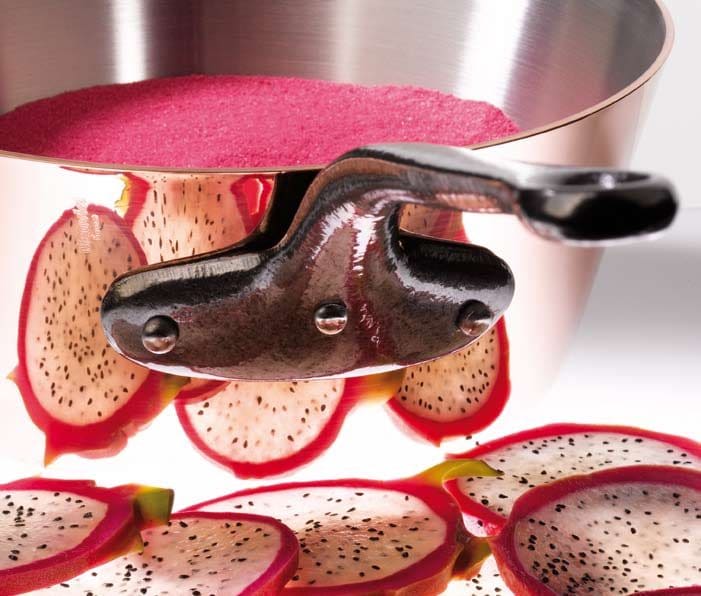
VFC, thanks for the excellent compilation and analysis. How can you create such a complex summary in such a short time?
Mauviel’s prices are going through the roof. For about half the price you can buy a freshly tinned pan of the appropriate size and thus better quality (thicker copper) on the second-hand market. With a little luck you can also find M’250 with both handle alternatives at significantly reduced prices. For a new purchase, I would personally prefer Falk (2.5 mm, pouring rim, cast iron handle)
However, when calculating Mauviel one must take into account that the price for copper in USD has increased by 52% since 2018 and by as much as 96% since 2016. So I can understand that Mauviel had to adjust the prices accordingly. On the other hand, the “false label” of describing 2 mm goods as professional is not acceptable to me.
Very enlightening. Thank you! I believe a fire, which caused the factory that made the cast iron handles for Mauviel to close in 2015, was the driver behind the change in handle design. I really feel for Mauviel today – they are truly stuck between a rock and a hard place. I think their choices were to raise M’250C prices to the point where an 8″ saucepan would cost something like $625 or economize the line to maintain pricing and profitability. Looks like their market research led them to make choice 2.
So the tin-lined copper is only 2.6 mm now? Just last August I bought a 32 cm Mauviel rondeau through Dehillerin when they advertised relatively cheap shipping prices to the USA. The rondeau has a thickness of 3.5 mm. The 2.6 mm would be a drastic reduction.
Stephen, that’s a good question. Up to Mauviel’s 2015 catalog M’Tradition was listed at 2-3.5mm, but since 2016 is specified at 2.6mm. I know anecdotally from you and others that some stock — especially at retailers like Dehillerin — can be much thicker. Could some stock on hand be pre-2016 production? It’s hard to know — but I encourage buyers of “new” tinned Mauviel to ask the retailer to check the thickness. There mays be super-thick gems still available at the same price as thinner pieces.
This is slightly depressing. I heard Mauviel was not fairing too well even before the pandemic and, for what it’s worth, somebody in the biz even told me a few months ago it was up for sale Let’s hope this is not their swan song.
This M200 line looks very similar to de Buyer’s Inocuivre with less attractive handles and Prima Matera without the induction capability (and with less attractive handles also). Both products are described on de Buyer’s website as 90% copper and 10% SS.
I’ve never cooked in a bimetal pan and wonder whether a 0.5 mm reduction in copper thickness could be less impactful where there is a SS lining in lieu of a tin one ?
In any case, for a new (non induction capable) stainless lined pan, I guess I would turn to Matfer-Bourgeat as I don’t like Falk’s brushed finish.
As for a new tin lined pan, I’m sure Duparquet’s, BCC’s and House copper’s are great products but they all lack one thing : they’re not hammered.
As long as I use a gas stove and have sufficient strength, I’ll stick to my old über-thick, über-heavy, tin lined, beautiful HAMMERED pans !
With all understanding that the calculation has to take into account the drastically increased copper price, I wonder why other manufacturers have been able to keep their prices fairly constant.
Examples from Falk Culinair Classical Range (2.3mm copper + 0.2mm stainless steel, handles made of cast iron, pouring rim, Made in Belgium):
Sauteuse 24cm € 219
Rondeau 24cm € 255
Rondeau 28cm € 310
Stew pan 24cm € 230
Casserole 24cm € 315-349
Lid 24cm € 85
Lid 28cm €100
Unfortunately I only have the prices for the EU. Mauviel M’200CI with only 1.8mm copper is TWICE as expensive!
The quality of Matfer-Bourgeat is identical to that of Falk (only the look is different – glossy vs satin). The prices are also at the same level.
In my opinion, these blatant price differences have nothing to do with Covid. All European countries were similarly affected. Inflation in the EU is currently around 2%. In some industries, prices go up by up to 4%.
It feels as if Mauviel wants to leave the BtoB world (unless significant discounts are offered to pros) and tries to reposition itself as a luxury consumer brand. Have you seen their new outdoor collection ? And the prices ?
Madame Le Guern Gilbert, the President of Mauviel, is certainly an excellent business woman. She continually discovers and uses new business ideas for which she can cleverly fall back on existing materials and technologies in her house. The typical handles, hammered or brushed aluminum are not only used for pans, but also for chopping blocks and all kinds of containers and accessories. Some customers prefer to buy everything from a single source for convenience.
On material thickness: https://www.mauviel.com/file/2020/03/164-173Technique-N19.pdf
“Conventionally, a thickness of 2.5 millimeters for all that is cooking. Beware of too thin saucepans which will
burn your food before cooking it! The thin utensils (1.5 millimeters thick) are reserved for the service when we bring to
table, for example, a sauce in a pretty copper pan. ” (translation from French)
In my many years of personal experience, cooking with copper 1.2-2 mm thick, as was often the case with pans made exclusively by hand in the 19th century, but also by some manufacturers today, requires the greatest caution. Thin copper heats up extremely quickly, so there is always the risk of burning the food. Far too stressful for me and therefore unsuitable.
If I understand correctly and the thicker pans are cheaper than the M200 then it would seem like they are trying to offload them prior to discontinuing the line. There is a repositioning as a trendy luxury lifestyle product happening here rather than superb heirloom copper. The real thing does not have built in obsolescence as we know which represents a problem if you want to keep selling. This can only damage the reputation of the company amongst serious cooks but there may be a far bigger and very lucrative market selling to people who don’t know or care that the product isn’t as good as it could be and probably will use it principally as decor.
Nick, as far as I’ve seen, Bourgeat Alliance copper pans are only available from remnants or very rarely used (at least in Europe). I also have 4 of these pans that I’m keeping. This series no longer appears in the current Matfer-Bourgeat catalogs. So again one less alternative for Cu + Inox fans. There are still Falk, de Buyer and Mauviel.
Solid copper has long since disappeared in the large kitchens of restaurants, hotels, hospitals and canteens – too expensive, too maintenance-intensive. I did not find a single copper pan in the catalogs of corresponding outfitters of large kitchens. Copper pans (regardless of whether they are lined with stainless steel or tinned) can only be found in a few exclusive restaurants and in private households that can afford this noble material. Mauviel does not have to take this clientele into account when setting prices. The company can even afford to downgrade the quality while maintaining the high prices.
Martin,
The 2.5mm Alliance line remains predominantly featured on Matferbourgeat US website : https://matferbourgeatusa.com/product-category/cookware/ and still appears in the latest catalogs available on matferbourgeat.com : http://e-catalogues.matferbourgeat.com/2020/matfer/en/26/ or http://e-catalogues.matferbourgeat.com/2019/mbi/fr/24/index.html
I’ll give you that it’s rather more confidential than Falk, de Buyer or Mauviel as Matfer Bourgeat targets predominantly the commercial market and don’t sell directly to consumers unlike its competitors. That said, I understand Bourgeat copper enjoys a very good reputation in the few professional kitchens and laboratories that still use copper cookware. Falk on the contrary do not seem to have a very strong presence in the high end Michelin starred kitchens.
IMO, Bourgeat pans look far better than Falk’s : smooth copper vs. brushed + no loud display of brand on the handle.
They might be a little more expensive than Falk’s but remain in any case way cheaper than Mauviel’s.
Roger,
I totally agree with your post. Actually, your observation on obsolescence made me think : could tin lining be considered as a kind of built in obsolescence ? I wonder how important retinning was in Dehillerin’s, Jacquotot’s or Gaillard’s business plan in the 1930’s ?
Nick, thanks for the links. Sometimes the internet is a maze. I had researched Matfer-Bourgeat several times, but this catalog was hidden from me. In the past few decades there were only 2-3 internet shops in Germany that had the Bourgeat Alliance on offer. There is no longer any.
My passion for copper began with Bourgeat Alliance pans. In 1994 I bought the first pans, which were then offered for a short time by bulthaup, a manufacturer of luxury kitchens, under their own name. As my passion grew, I later bought more Bourgeat pans directly from Belgium. I loved them dearly, but my curiosity about other manufacturers and, increasingly, my interest in vintage and antique pans were stronger than my principle of only buying as many pans as I actually needed for cooking. For a long time I didn’t like the satined copper of the Falk pans either. But now I like this one too, especially since I have enough sparkling copper in my kitchen. The practical benefit is incredible. You can use the pans for a very long time without the appearance of the copper changing significantly. It’s a matter of taste.
I would be very interested to see exactly where copper pans (of any kind) are used in restaurants. Do you have any links to this? Some time ago I found photos of exclusive kitchens on the Internet, in which huge batteries of fine copper pots could be seen. I still have the photos, but no longer the links. But when I saw videos of star chefs and other top chefs, everyone was cooking with stainless steel pans. Does anyone have any links where you can see top chefs cooking with copper pans?
Now I’ve found a link that shows copper pans in restaurants. Unfortunately, the finest kitchens I’ve seen are missing.
https://www.hungryonion.org/t/fine-restaurants-using-copper-cookware-list-em-here/3571/34
What Cookware Do Professional Chefs Use?
https://www.onlycookware.com/what-cookware-do-professional-chefs-use/
Hallo, Martin ! Danke ebenfalls für deinen Links.
Here is another one showing a two stars Michelin chef cooking a double veal chop in a copper sauté pan: https://www.youtube.com/watch?v=3i3KPJy8WLo&t=129s
Look at the tin lining !
By the way, Martin, I’m curious: what kind of cookware do you use most? SS lined or tin lined?
Nick, thanks for the link. Yeah, I saw the well-seasoned tin lining and stainless steel pans in the background. 😉
Since I like the look of hammered copper pans the best, and these tinned pans have the thickest bottoms, that’s what I use them the most. But since I’m pragmatic, SS lined copper, carbon iron pans and occasionally cast iron roasting pans and grill pans are also used. And sometimes I have fun proving that you can fry meat and fish without sticking with copper pans lined with stainless steel. Even with this combination of materials, careful heat control is good advice. There is so much prejudice in all directions. Since tinning is not exactly cheap fun, it would be better to use stainless steel-clad copper pans or inexpensive stainless steel pots for boiling liquids of all kinds. Copper has practically no thermal advantage here. But since I love copper, I even boil pasta water in fine copper. You can see part of my “batterie de cuisine” on VFC.
Nick, thanks also for that link. I love veal chops and I will eventually try that recipe. The only difference in technique will be the use of wood or plastic utensils in the cooking! (:
Martin,
Please be assured that I, like all readers of VFC’s site I presume, have already admired (or should I say drooled over?) your batterie de cuisine, the elegance of its proud display and the quality of the photography ! I noticed the nice carbon steel frying pans with the forged handles (by the way, I’ve never seen such pans. Where do they come from?) but missed to spot any SS lined copper and assumed that the hidden part of your batterie was more tin lined copper. Hence my surprise and curiosity when your Bourgeat and Falk pans came out of the cupboard!
I’ve since revisited the post on your batterie and bam ! a pan winked at me from its pouring rim directly from the foreground of the first pic. I guess it’s one of your Bourgeat, hidden in plain sight !
Your request to see top chefs cooking with copper pans led me to play a little game. I took the list of the Michelin 3 star restaurant (https://en.wikipedia.org/wiki/List_of_Michelin_3-star_restaurants) and googled them one after the other, searching for videos of their kitchen. Of course, I didn’t too all of them (yet ;-)). So far : no copper at all in the German kitchens, some in the US and Spanish ones but, maybe no surprise there, I was able to spot copper in action on the stove in almost all the French restaurants: in the old Parisian Hotels (like the George V : https://www.youtube.com/watch?v=OL-Fkz-E6gk or the Bristol : from 24:30 https://www.youtube.com/watch?v=dcIUl0d8MYE ) as well as in the more modern establishments in the provinces like the Clos des Sens ( https://www.youtube.com/watch?v=gqFTpit_Hd8 ).
There’s also lots of gorgeous old copper at the Elysée Palace, the residence of the French president, and it’s apparently used everyday: https://www.youtube.com/watch?v=Pfl3miJ-qIc
I don’t know how I ended up on a Youtube channel called “recette vintage” (vintage recipe) which offers a selection of old cooking shows from French television. Some of them feature old gods of last century’s French gastronomy : Troisgros, Robuchon, Guérard and even Bocuse and you can see them whisking butter in copper windsors or poaching fish in a beautiful hammered aluminium turbotiere (that’s Pierre Troisgros in the Panaché de poissons à la jeannot).
Sorry, Stephen, but none of those French chefs, ancient or contemporary, seems to have received the memo on the prohibition of metal utensils in tin lined copper cookware.
Of course, most of what I found is in French but the colour of copper doesn’t change.
I don’t know what I enjoyed more : the search or watching the videos of great chefs in action. In any case, I hope that VFC and the readers of this site may find these videos as interesting or at least as entertaining as I did.
Nick, these videos would make for a fabulous post. I’d like to add them to the Cooking with Copper area of the site. I’ll ping you on email to discuss. Thank you so much for this!
Oops ! I’ve forgotten to paste the link to the “recette vintage” chanel. Here it is : https://www.youtube.com/channel/UC7gnE1bBnH7FCJE_MFgVrzg
Great, Nick, what you’ve researched and put together. Thank-you. I also enjoyed seeing beautiful copper pans between all the stainless steel in restaurant kitchens. But I don’t want to have to experience the hustle and bustle there every day. By chance I got stuck at the end of one of your videos and watched one more, then two more videos from a series that was also shown on German TV: “Royal dinner” or “Cuisine Royale” with star chef Michel Roth.
https://www.youtube.com/watch?v=odn7fwwAr6E
https://www.youtube.com/watch?v=68gRZtK4_M8
https://www.youtube.com/watch?v=1iL5ZazA7To
Rather a calm, nostalgic-romantic atmosphere and wonderful menus. Unfortunately no copper. But it is convincingly conveyed that you can also prepare wonderful dishes with stainless steel, cast iron cocotte, carbon iron pans and even with a ceramic gratin pan.
Charming and closer to my cooking “recette vintage”
Back to my kitchen ensemble. Nick, your eagle eye discovered my small but often used bulthaup Bourgeat saucepan. Next to it, however, there is still an SS copper saucepan from Mauviel. A Bourgeat frying pan is hidden on photos 3 and 5. A bulthaup Bourgeat Stewpan is on a shelf that I haven’t photographed. And there are still three different Falk pans in the oven. Yet almost everything that is easily accessible is tinned copper and is the most commonly used. Unfortunately, there was no room for other copper treasures in my small kitchen and are therefore kept in an adjoining room. The carbon iron pans were forged by hand by a German blacksmith. Nothing, absolutely nothing, sticks in these pans. The hollow handles not only feel good, they almost don’t heat up at all. I also think the carbon steel pans by Blanc Creatives are very nice and good. The hand-hammered pans by the Japanese Yuya Kobayashi (also with hollow handles) should be even more noble.
https://www.etsy.com/de/shop/YuyaKobayashi?ref=simple-shop-header-name&listing_id=542171560
Martin, I had my suspicions about the Mauviel saucepan because of the “silvery” hue of the rivets but I thought they might be tinned copper (I’ve got a few pieces like that). I totally missed the Bourgeat frying pan which I mistakenly took for hammered.
I know and use almost every day carbon steel pans which are basically steel (non stainless) but have never encountered carbon iron. You seem to consider there is a difference. Would you please explain in what way ?
In the Michel Roth videos, I found quite amusing that the name of the show which is “repas de fête” (festive meal) for the French audience becomes “royal dinner” in English for the German audience. I also noticed that for the French themed meal, the utensils on the table were set in the proper traditional French way i.e. with the tips of the forks and spoons facing the table.
Nick, you always look at things very carefully.
The different terms in German and English have caused confusion at one point or another. So I don’t give a guarantee.
Basically, the higher the proportion of carbon in steel, the more brittle it is. A low carbon content improves the forgeability of the steel. Disadvantage: carbon steel is not rustproof.
Cast iron or pig/raw iron (not malleable, so cannot be forged) contains the most carbon 2 – 6.7% (Le Creuset, Staub, Skeppshult, Carl Victor, Logic)
Tool steel 0.5 – 2% carbon
Carbon steel contains 1.8 – 2% carbon (de Buyer Mineral B)
Wrought iron contains <1.8% carbon (Turk, Gräwe, GSW and my pans from Ulrich Blaut)
Knife steel consists only of iron and carbon, if possible, in order to enable a very fine steel structure and thus a razor-sharp and sharp-edged blade.
A “stainless” steel is alloyed with at least 13% chromium and nickel (? %) to protect it against acids and moisture. Positive for common cutlery and outdoor knives, but also as thin protection on copper pans. However, knives made of chrome steel are less sharp and the cutting edge is less stable.
I had to smile when I saw the presentation of a "typical German dish" in one of M. Roth's videos. All Germans would live in paradise if we dined like that. The reality is not as bad as some prejudices would lead you to believe, but there is still a lot of room for improvement.
Wonderful idea, VFC !
Hey Martin !
Thanks for the clarifications.
As regards the German dinner, the traditional cold Abendbrot is way too ascetic for my taste and I find it even almost masochistic in nature especially in wintertime 🙂
Hey VFC !
Your article is mentioned on Chowhound : https://www.chowhound.com/post/mauviel-copper-cast-iron-handles-split-falk-copper-cookware-1096958
Hey Nick! Thanks for flagging the mention on Chowhound. It’s a really good site for cooking and cookware advice, and helped me to get started with copper. There are some very experienced cooks and copper collectors who comment there, and I hope that some of them also participate here. My attitude is, the more the merrier so that we can learn from each other’s experience to develop our own style of cooking with and collecting copper.
Hallo Nick, typical dinner of our compatriot and role model Jan Frodeno (triathlon world record): fish with a large salad – with nuts, tuna, quinoa and sweet potatoes. There is only one espresso for breakfast. To stay fit and have enough energy for training, Frodeno drinks protein shakes with frozen bananas and a large portion of peanut butter. In the afternoon he likes to make himself a gluten-free bread with lots of avocado and a fried egg.
I can see parallels to my nutrition, but there are still some gaps.
:-))
He’s the Ironman, you’re the Kupferman !
Hi VFC! It sounds like Mauviel is doing what luxury brands like Chanel do too often… decreasing its quality and increasing its prices to maintain a niche “luxury” status that only few can afford… in this case in the cookware department. The catch is, many of us copper enthusiasts know what to look for and spend money on, however there are many people who don’t… I often find myself giving lessons to interested family and friends who aren’t normally that interested in cookware… so they’d fall victim. Or this could simply be another example of inflation? I guess we’ll have to wait and see. I plan to stick to the old stuff! It has way more character 🙂
Great column, VFC. I’m intrigued about the “250CI” pieces on the website that you say aren’t supposed to exist. Do you think these really are the M250c bodies with real cast iron handles? If so, isn’t that sort of a return to the pre-2015 M250c materials? Is there any reason to think they’re inferior in any respect to the 2015-2021 M250c line? 2.5mm with real cast iron seems infinitely preferable to 2.0mm with real cast iron, no? Particularly at a lower price!
Hey ACW! I don’t know what the deal is with the “250CI” — they’re on the website and available for purchase at a discount, but the “official” catalog doesn’t mention them. My one thought is that Mauviel has a bunch of new CI handles and a backlog of 2.5mm 250 pan bodies and is doing the right thing by working through that inventory. It would be wonderful if a reader has bought a “250CI” piece and can report back, but it’s a significant risk to take.
While I have readers on the line, please check out the “product details” for the 250C saute pans: “The saute pan predestine to slow cooking. As a result, their very thick bottom, 2.5 to 4 mm, guarantees a smooth and uniform distribution of heat.” A 4mm base on a bimetal pan? This would violate the laws of physics that bimetal can’t exceed 2.5mm. Do any of you have a 250 piece that is 4mm thick in the base?
https://mauviel-usa.com/collections/summer-sets/products/m-heritage-250c-sautepan-with-lid?variant=32878829142069
https://mauviel-usa.com/collections/summer-sets/products/m-heritage-250c-sautepan-with-lid?variant=32878829076533
https://mauviel-usa.com/collections/summer-sets/products/m-heritage-250c-sautepan-with-lid?variant=32878829109301
Nick – French chef, commercial kitchen, who cares about metal utensils. These are businesses, not a home. If it needs re-tinning it goes out to the tinner as a business cost. For me Mauviel is history. I have a bit of M250c and I’m happy. I wouldn’t consider the new two rivet handles – strictly for tradition’s sake.
So interesting, thanks to you all for a good read.
I’m now in full buyers remorse mode.
I’m new to copper cookware and didn’t perform a thorough research beforehand, so I’m in the middle of my starting-off and bought an M’150b sauté pan.
Now reading this, this feels nothing short of a joke.
You choose to start-off with copper cookware to invest in gear that’s suppsed to last a lifetime and brings professional-grade performance. You choose a traditional OEM with heritage that’s like the Rolls-Royce of cookware manufacturing. You even choose to lay down that extra money for copper instead of the stainless steel line M’Cook (which surely does a very great job on its own already).
Only to find out you bought the ‘fake’ consumer half assed copper line that’s intended for waiters to pretend to be cooking. What a fucking joke
Hi VFC!
I just recently discovered that my 20cm Mauviel M250c saucepan is only 2.0mm thick copper, measured at the top. I purchased it through Amazon in June of 2014 as an M250c saucepan as is still shown by my Amazon purchase record.
The cardboard carton it was shipped in has a label with the following:
Mauviel M’Heritage M250c
6501.21 3-1/2 – Quart
Saucepan with Lid, Cast Iron Handle
It has a real cast iron handle with 3 rivets.
The stamp by the handle reads:
Mauviel 1830
France
All my other M250c Mauviel pans are 2.5mm.
This is the only Mauviel pan in my battery that has the Mauviel 1830 stamp.
This was flat out deceptive marketing. Needless to say I am very disappointed. It is long past being able to do anything.
I am now a convert to Matfer-Bourgeat and have long ago purchased my last Mauviel pan.
Indeed, this is annoying. The final digit “21” of the order number is unusual, although on the net you can see many (former) offers with this number. With the final digit Mauviel indicates the diameter of a pan. The usual order number with 2.5mm wall thickness was 6501.20. I suspect that 6501.21 refers to a special series with a smaller wall thickness. However, I had never heard or read about it.
The quality of Matfer-Bourgeat is in no way inferior to Mauviel. Rather, I see advantages with these pans (pouring rim, material thickness for the lids greater).
Thanks for the info Martin, it clears the air a bit.
I should have mentioned that I do have a 22cm 1.5mm frypan (6413.22) so I know exactly how the M150c thickness appears. The pan in question is definitely 2.0mm (micrometer with a ball bearing on the inside) and I wonder if this pan was a 2014 precursor to the current unacceptably thin 200 series. There is no doubt that Mauviel intentionally misrepresented this pan as a M250c.
A while ago I was offered a Matfer-Bourgeat 8 piece set at a price I could not pass up and I could not be happier. I consider M-B the best stainless lined copper cookware currently available without question (Falk is good, but funky handles and no polish). I would consider the Mauviel tin-lined, but I already have the few Mauviel oddball tin pieces I wanted.
Many years ago I read a detailed review in a US forum about stainless steel coated pans from Mauviel, Bourgeat and Falk. The reviewer concluded that the pans from the three brands were absolutely equivalent. The differences were marginal and purely a matter of taste. In principle, this is also my experience after many years of cooking with pans from these three manufacturers. Bourgeat’s design has changed virtually nothing in 25 years. Mauviel experimented (unfortunately) with the material and the design of the handles. I have less experience with Falk and don’t know the older designs (pre-2000).
Over and over again I read that Falk is supposed to have thinner handles. I cannot confirm this with the smaller (up to 20cm) saucepans or the sauté pans with beveled walls. I have measured the handles of all three manufacturers and carried out a haptic grip test several times. Only a tinned Dehillerin (Mauviel?) saucepan from about 1950-60 has a handle that is about 1mm wider at the bend. All other handles have a width of about 20mm at the bend. The rest of the handles to the eyelet are also virtually identical. The pans from Mauviel have a slightly more pronounced curvature at these sizes than the other two manufacturers. Overall, the manufacturers’ handles feel very similar to me. Even the handle of a 1900 Dehillerin sauté pan included in the comparison didn’t feel any different. The result may be different for larger sizes. But in this category, I have no suitable saucepans from either Bourgeat, or Falk.
For a long time, only pans with a high-gloss finish came into question for me. But since I like to experiment and had the opportunity to purchase Falk pans at a good price, I grabbed them. The practical advantages of Falk’s brushed polish are truly amazing. These pans hardly darken at all. Don’t ask me why that is. A freshly polished Mauviel sauté pan doesn’t shine any brighter or stronger than a Falk after just one or two uses for gentle sautéing. While the soft shine of the Falk lasts for a very long time, the Mauviel and Bourgeat get darker and darker.
I have some of my pans tinned at Atelier du Cuivre, Villedieu. This workshop recommends a brushed polish after tinning if a pan is to be used for cooking. By default, this small manufacturer always sells new pans with a satin finish. If a pan is to be used for decorative purposes, the high-gloss polish is recommended. However, I do not follow this recommendation and always order high gloss. This is the classic finish for me. Therefore, I accept the disadvantages mentioned. Nevertheless, I am always amazed at the resistance of Falk’s brushed finish to darkening.
Since we had to let all the scullery (and kitchen) maids go some time ago 😉 I have gotten used to my “old copper penny” cookware. Occasionally, only occasionally, I will polish a few in the days before Christmas/New Year’s.